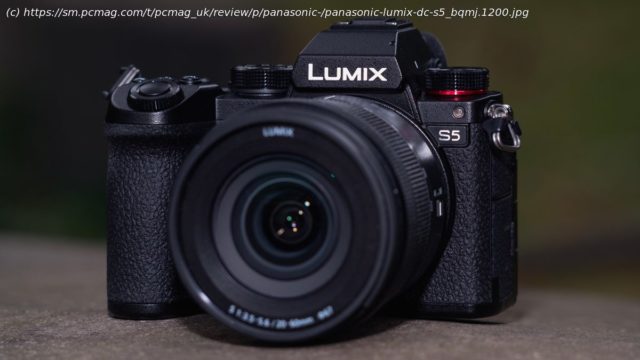An excellent all-around performer with superb 24MP stills, 10-bit 4K, and an all-weather build
Panasonic went big with its first-generation Lumix DC-S1 full-frame mirrorless camera, both in size (it’s as hefty as some SLRs) and price, positioning it around $2,500, toward the high-end of the range for a 24MP model. It’s targeting a more entry-level market with the Lumix DC-S5 ($1,999.99, body only), but instead of cutting back on features, the S5 is a bit more capable, offering improved video features and better autofocus. It’s a great entry point for full-frame imaging, and a winner of our Editors’ Choice award. Solid Build, L-Mount Compatibility The Lumix S5 follows the standard design paradigm followed by most full-frame mirrorless cameras. It’s finished in basic black, and at 3.8 by 5.2 by 3.2 inches (HWD), is a bit slimmer all around than the S1 and S1R (4.3 by 5.9 by 3.8 inches). It’s also notably lighter, at about 1.6 pounds without a lens, versus 2.2 pounds for Panasonic’s bigger full-frame offerings. Lumix S 20-60mm F3.5-5.6,20mm, f/22,1/60-second, ISO 320 We criticized the S1 and S1R for being on the large side, but the S5 gets ergonomics right. A deep handgrip makes it a good fit for lenses large and small, and the camera itself is built tough, with a magnesium frame and an all-weather, dust-and-splash-protected design. You can buy the camera on its own for around $2,000, or spend another $300 for a kit option with the Lumix S 20-60mm F3.5-5.6 zoom. If you’re just getting started with an L-mount system, the kit lens is a worthwhile addition—its optics are sound, and it covers a much wider angle of view than other starter zooms, a plus for vlogging, travel, and tight interiors. The S5 is compatible with L-mount lenses, available from Leica, Panasonic, and Sigma—the L-Mount Alliance—and is bolstered by third parties offering boutique manual focus optics. The main trio has the basics covered, though, from quality starter lenses like the S 20-60mm, to pro-grade F2.8 zooms, and bright F1.2 and F1.4 prime options. Leica has the exotic, high end covered, but be aware there are still some specialized lenses you can buy for a Sony camera system that aren’t in L-mount yet. We don’t expect a lot of S5 buyers to be in the market for a $13,000 600mm F4, but if you are, get a Sony. Lumix S 20-60mm F3.5-5.6,20mm, f/4.5,1/400-second, ISO 100 For most of us, L-mount has the basics covered. Autofocus lenses cover focal lengths from 14 through 400mm, and teleconverters extend the Sigma 100-400mm Contemporary as far as 800mm. Controls and Ergonomics The S5’s controls are absolutely pro-grade. It sports front and rear dials on the top plate, as well as a flat command dial on the rear, so you can take full control over exposure, and there are switches to toggle drive mode, focus mode, and an AF-ON button, settings you’ll adjust when photographing different subjects. Buttons and dials have a good feel—they respond with confidence, and no mush at all. They’re supplemented by a smart on-screen interface, activated by the Q button. It gives touch (or button-based) access to another dozen options, and is fully customizable.






